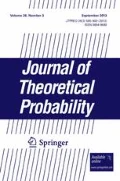Abstract
In this paper, we obtain a rate of convergence in the central limit theorem for high order weighted Hermite variations of the fractional Brownian motion. The proof is based on the techniques of Malliavin calculus and the quantitative stable limit theorems proved by Nourdin et al. (Ann Probab 44:1–41, 2016).
Similar content being viewed by others
References
Barthe, F.: On a reverse form of the Brascamp–Lieb inequality. Invent. Math. 134, 335–368 (1998)
Bennett, J., Carbery, A., Christ, M., Tao, T.: The Brascamp–Lieb inequalities: finiteness, structure and extremals. Geom. Funct. Anal. 17(5), 1343–1415 (2008)
Binotto, G., Nourdin, I., Nualart, D.: Weak symmetric integrals with respect to the fractional Brownian motion (2016). Ann. Probab. 46(4), 2243–2267 (2018)
Brascamp, H.J., Lieb, E.H.: Best constants in Young’s inequality, its converse, and its generalization to more than three functions. Adv. Math. 20(2), 151–173 (1976)
Breuer, P., Major, P.: Central limit theorems for nonlinear functionals of Gaussian fields. J. Multivariate Anal. 13, 425–441 (1983)
Gradinaru, M., Nourdin, I.: Milstein’s type schemes for fractional SDEs. Ann. Inst. H. Poincaré Probab. Statist. 45(4), 1085–1098 (2009)
Mandelbrot, B.B., Van Ness, J.W.: Fractional Brownian motions, fractional noises and applications. SIAM Rev. 10, 422–437 (1968)
Mishkov, R.: Generalization of the formula of Faa di Bruno for a composite function with a vector argument. Int. J. Math. Math. Sci. 24(7), 481–491 (2000)
Neuenkirch, A., Nourdin, I.: Exact rate of convergence of some approximation schemes associated to SDEs driven by a fractional Brownian motion. J. Theor. Probab. 20, 871–899 (2007)
Nourdin, I.: Asymptotic behavior of weighted quadratic and cubic variations of fractional Brownian motion. Ann. Probab. 36(6), 2159–2175 (2008)
Nourdin, I.: Selected Aspects of Fractional Brownian Motion. Springer, Berlin (2012)
Nourdin, I., Nualart, D.: Central limit theorems for multiple Skorohod integrals. J. Theor. Probab. 23(1), 39–64 (2010)
Nourdin, I., Nualart, D., Peccati, G.: Quantitative stable limit theorems on the Wiener space. Ann. Probab. 44(1), 1–41 (2016)
Nourdin, I., Nualart, D., Tudor, C.A.: Central and non-central limit theorems for weighted power variations of fractional Brownian motion. Ann. Inst. Henri Poincaré 46(4), 1055–1079 (2010)
Nourdin, I., Peccati, G.: Normal Approximations with Malliavin Calculus. From Stein’s Method to Universality. Cambridge University Press, Cambridge (2012)
Nourdin, I., Réveillac, A.: Asymptotic behavior of weighted quadratic variations of fractional Brownian motion: the critical case \(H=1/4\). Ann. Probab. 37(6), 2200–2230 (2009)
Nourdin, I., Réveillac, A., Swanson, J.: The weak Stratonovich integral with respect to fractional Brownian motion with Hurst parameter 1/6. Electron. J. Probab. 15, 2117–2162 (2010)
Nualart, D.: The Malliavin calculus and related topics, 2nd edn. Springer, Berlin (2006)
Nualart, D., Zhou. H.: Total variation estimates in the Breuer-Major theorem. Preprint, arXiv:1807.09707
Acknowledgements
We would like to thank an anonymous referee for his/her valuable comments.
Author information
Authors and Affiliations
Corresponding author
Additional information
Publisher's Note
Springer Nature remains neutral with regard to jurisdictional claims in published maps and institutional affiliations.
The work of D. Nualart is supported by the NSF Grant DMS 1811181.
Appendix
Appendix
Here we prove a result we need in the proof of Theorem 1.1. Recall the notation \(D_{k/n} F = \langle DF, \delta _{k/n}\rangle _{\mathfrak {H}}\) where \(\delta _{k/n} =\mathbb {1}_{[k/n,(k+1)/n]}\).
Lemma 4.1
For any integers \(\ell , M, a,b,c\) such that \(M\ge 0\), \(0\le c\le q\), \(0\le a\le q-c\), \(0\le b\le c\) and any real number \(p>1\),there exists a constant C depending on q, M, p, and the Hurst parameter H such that
where
Proof
For \(0\le m\le M\), let
Taking the norm in \(\mathfrak {H}^{m+q-2b+c}\), we have
We consider three different cases:
Case 1 Suppose that \(0<b<q\). Applying Lemma 2.4 to \(\sum _{j,j'=0}^{n-1}|\beta _{j,k}|^b|\beta _{j',k}|^b |\beta _{j,j'}|^{q-b}\) and Lemma 2.1(a) to each of the \(\alpha \) terms, we have
When \(H\le 1/2\), \(q+b\ge 2\ge 1/(1-H)\), so \(-H(q+b) \ge 1-(q+b)\), and we have
When \(H>1/2\),
Case 2 Suppose that \(b=q\). In this case, \(c=q\) and \(a=0\) and, applying Lemma 2.2(a),
Note that \(-2qH = (-2qH)\vee (1-2q)\). Thus, this estimate coincides with the estimate in case 1 when \(b=c=q\) and \(a=0\).
Case 3 Suppose that \(b=0\). Applying Lemma 2.2(b) to \(\sum _{j,j'=0}^{n-1} |\beta _{j,j'}|^q\) and Lemma 2.1(a) to each of the \(\alpha \) terms,
This concludes the proof of the lemma. \(\square \)
Rights and permissions
About this article
Cite this article
Ma, N., Nualart, D. Rate of Convergence for the Weighted Hermite Variations of the Fractional Brownian Motion. J Theor Probab 33, 1919–1947 (2020). https://doi.org/10.1007/s10959-019-00940-x
Received:
Revised:
Published:
Issue Date:
DOI: https://doi.org/10.1007/s10959-019-00940-x


